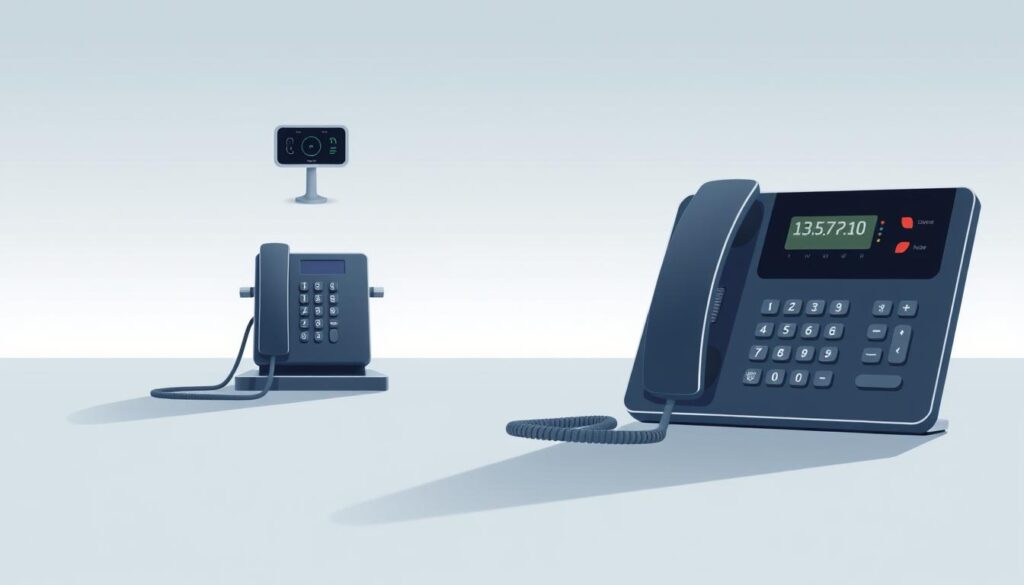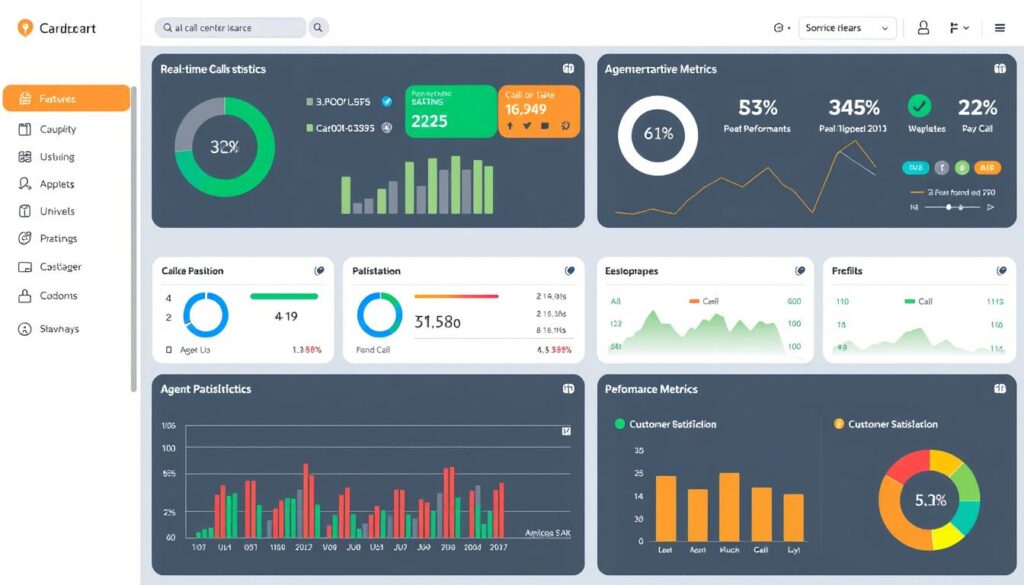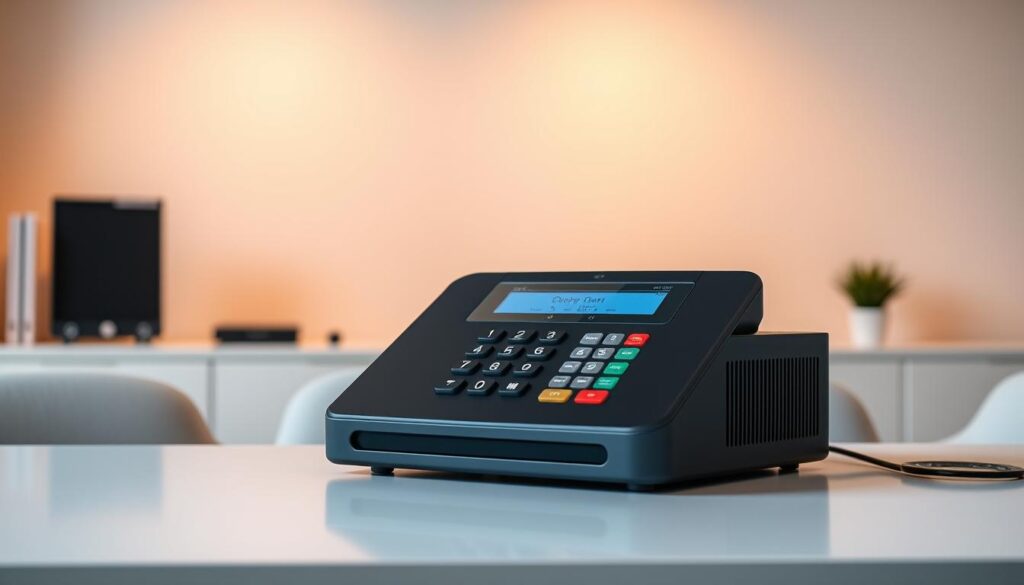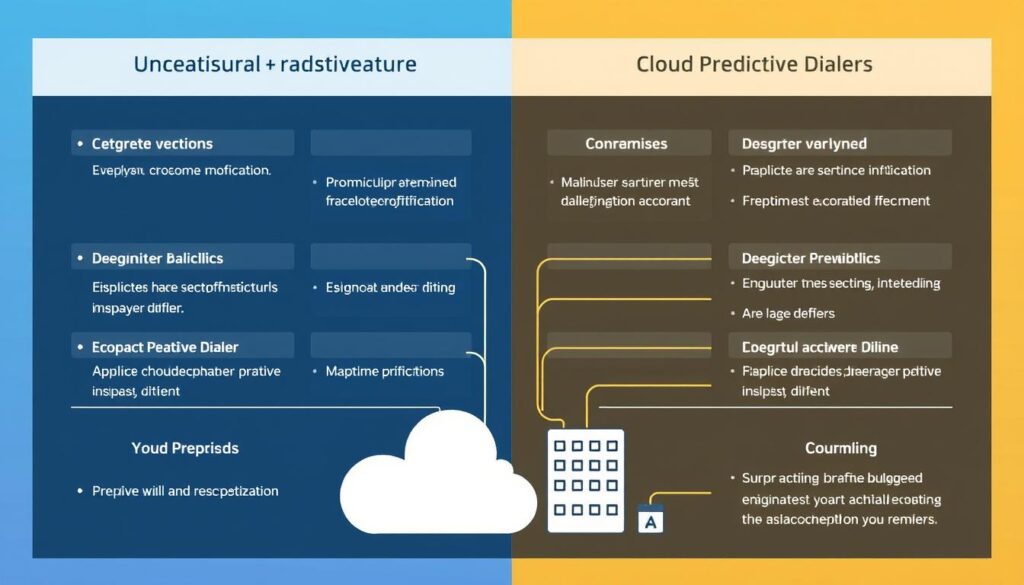Are you tired of hearing the same old message: “We’re sorry, we couldn’t reach you”? Outbound calling campaigns can be a challenge for businesses, with wasted calls and unproductive time being a significant issue.
A predictive dialer is a game-changer in the call center industry, automating the outbound calling process to maximize agent productivity and campaign effectiveness.
By leveraging advanced technology, businesses can increase connection rates, improve overall efficiency, and optimize their outbound call operations. In this article, we’ll explore how predictive dialers work and their key benefits for outbound calling campaigns.
What Are Predictive Dialers?

At the heart of efficient outbound calling campaigns lies the technology of predictive dialers. A predictive dialer is an automatic dialing system for outbound calling that’s designed to increase agent efficiency. It does this by calling contacts before agents are available for another interaction.
Predictive dialers are automated phone systems that intelligently dial multiple numbers simultaneously before agents become available, optimizing the outbound calling process. Unlike manual dialing methods, predictive dialers use sophisticated algorithms to determine when to place calls, analyzing factors such as agent availability, average call duration, and connection rates.
These systems are designed to maximize agent talk time by eliminating unproductive activities like manual dialing, listening to busy signals, and reaching answering machines. Predictive dialers represent the most advanced form of auto dialers, offering significant improvements in efficiency and productivity for call centers handling high volumes of outbound calls.
The core purpose of a predictive dialer is to ensure agents spend more time speaking with live contacts and less time waiting between calls, dramatically increasing the number of successful connections per hour. Originally designed by Douglas Samuelson as a hardware-based solution to make debt collection for overdue payments and telemarketing workflow more efficient in the late 1980s, the technology has since evolved into cloud contact center software.
By leveraging predictive dialing technology, businesses can significantly enhance their outbound call operations, leading to improved productivity and reduced idle time for agents. This makes predictive dialers an indispensable tool in modern call centers.
The Evolution of Predictive Dialers
Since its emergence in the late 1980s, predictive dialer technology has transitioned from a niche hardware solution to a comprehensive software system. Originally designed by Douglas Samuelson as a hardware-based solution to make debt collection for overdue payments and telemarketing workflow more efficient, the technology has since evolved into cloud contact center software—known as a hosted predictive dialer—with the ability to serve businesses outside of collection agencies at an affordable cost.
The first predictive dialers were hardware-based and primarily served debt collection agencies and telemarketing operations. As technology advanced, these systems evolved into software-based dialing solutions that could be integrated with existing telephony infrastructure in call centers. The rise of cloud computing further transformed dialer technology, making it more accessible and scalable for businesses of all sizes.

Modern predictive dialers now incorporate advanced features like AI-driven analytics and seamless integration with CRM systems. This evolution represents a significant shift from their single-purpose predecessors, offering a robust solution for various industries. The technology has made it possible for businesses to optimize their outbound campaigns efficiently.
How Predictive Dialers Work
At the heart of predictive dialer technology lies a sophisticated system that analyzes various factors to optimize call connections. This technology is designed to maximize the efficiency of outbound calling campaigns by automating the dialing process and ensuring that agents are connected to live calls more frequently.
Pacing Algorithms Explained
Predictive dialers utilize complex pacing algorithms to determine the optimal time to dial a call. These algorithms consider factors such as the number of available agents, the likelihood of call answers, and the historical data on call durations. By analyzing these factors, the dialer can adjust its dialing speed to match the pace at which agents can handle calls, thereby minimizing idle time and maximizing productivity.

Call Connection Process
The call connection process involves several steps that ensure calls are connected to agents efficiently. Once a call is answered, the predictive dialer quickly determines whether the call is a live answer or an answering machine. If it’s a live answer, the call is immediately connected to an available agent. This process happens rapidly, often in a matter of seconds, to ensure a seamless experience for both the caller and the agent.
Answering Machine Detection
Answering machine detection (AMD) is a critical component of predictive dialer technology that distinguishes between live human answers and automated answering systems. The technology analyzes audio patterns in the first few seconds of a call to determine whether a human or machine has answered, using factors such as voice patterns, pauses, and tonal qualities. Advanced AMD systems achieve accuracy rates of 90-95%, though false positives and false negatives can still occur. Effective AMD significantly increases agent efficiency by ensuring they only engage with live contacts rather than wasting time listening to answering machine greetings or leaving voicemails.
Predictive Dialers vs. Other Dialing Systems
When it comes to outbound campaigns, the choice of dialing system can significantly impact efficiency and results. Different dialing systems are designed to cater to various needs and priorities, such as call volume, agent productivity, and call quality.
Predictive Dialers vs. Auto Dialers
Predictive dialers and auto dialers are often used interchangeably, but predictive dialers are a more advanced form of auto dialer. While auto dialers automatically dial numbers, predictive dialers use complex algorithms to predict when an agent will become available and dial accordingly. This results in higher connection rates and increased agent productivity. Auto dialers, on the other hand, may not always optimize calls for available agents.
The key advantage of predictive dialers over basic auto dialers is their ability to analyze call data and adjust dialing rates in real-time. This ensures that agents are utilized efficiently and that calls are connected promptly.
Predictive Dialers vs. Progressive Dialers
Progressive dialers dial numbers only when an agent is available, ensuring that calls are connected as soon as an agent is free. Unlike predictive dialers, progressive dialers do not dial multiple calls for each available agent. This approach can lead to lower abandonment rates since calls are only made when an agent is ready to take them.
- Predictive dialers prioritize volume and efficiency.
- Progressive dialers focus on ensuring that calls are connected to available agents.
- The choice between predictive and progressive dialers depends on campaign goals and priorities.
Predictive Dialers vs. Preview Dialers
Preview dialers provide agents with contact information before initiating a call, allowing them to review details and prepare. This is particularly useful for complex sales scenarios or sensitive conversations. Unlike predictive dialers, preview dialers give agents control over when a call is placed.
While predictive dialers excel in terms of call volume and agent utilization, preview dialers emphasize call quality and preparation. The choice between these dialing systems depends on whether the priority is efficiency or personalized service.

Key Features of Predictive Dialer Software

The effectiveness of predictive dialer software lies in its advanced features, which are designed to optimize the efficiency and productivity of outbound calling campaigns. These features enable call centers to streamline their operations, improve agent productivity, and enhance customer interactions.
Answering Machine Detection (AMD)
Answering Machine Detection is a critical feature that enables predictive dialer software to distinguish between human answers and answering machines. This ensures that calls are connected to agents only when a live person is on the line, saving time and increasing the effectiveness of the campaign.
Do Not Call (DNC) Management
DNC management is another essential feature that helps businesses comply with regulatory requirements. Predictive dialer software with DNC management capabilities can scrub contact lists against DNC registries, reducing the risk of non-compliance and associated penalties.
Real-time List Management
Real-time list management allows call center managers to monitor and adjust their contact lists dynamically. This feature enables them to update lists based on campaign performance, ensuring that the most relevant and responsive contacts are targeted.
Call Recording and Monitoring
Call recording and monitoring capabilities are vital for quality assurance, training, and compliance purposes. With call recording, supervisors can capture agent interactions, provide feedback, and ensure that agents adhere to best practices. Advanced monitoring systems include features like whisper coaching and call barging, enabling real-time intervention and support.
Some of the key benefits of call recording and monitoring include:
- Capturing agent interactions for quality assurance and training purposes
- Enabling real-time monitoring of live calls for immediate assistance or intervention
- Providing valuable training resources through recorded calls
- Including advanced features like whisper coaching and call barging
- Ensuring compliance with regulatory requirements regarding disclosures and prohibited practices
By incorporating these advanced features, predictive dialer software can significantly enhance the efficiency and effectiveness of outbound calling campaigns, leading to improved agent productivity and better customer interactions.
Benefits of Using Predictive Dialers
The implementation of predictive dialers in outbound campaigns has revolutionized the way businesses approach customer outreach. By automating the dialing process and optimizing call connections, predictive dialers significantly enhance the overall efficiency of call centers.

Increased Agent Productivity
One of the primary benefits of using a predictive dialer is the significant increase in agent productivity. Because the outbound dialer makes calls so quickly, your agents will not have to sit around doing nothing. The dialer will rapidly have calls ready for them; by the time they are done with their current call, the system will likely have another one ready for them to take on. This continuous workflow allows agents to handle more calls, thereby increasing their productivity and contributing to better sales results.
Higher Connection Rates
Predictive dialers are designed to maximize connection rates by dialing multiple numbers simultaneously and connecting answered calls to available agents. This approach not only increases the number of successful connections but also reduces the time spent on unproductive calls. As a result, campaigns managed by predictive dialers achieve higher connection rates, leading to more meaningful interactions and potentially better campaign outcomes.
Reduced Idle Time
The advanced algorithms used in predictive dialers minimize idle time for agents by ensuring a steady stream of calls. By analyzing various factors such as agent availability and call answer rates, predictive dialers adjust their dialing pace to keep agents engaged. This reduction in idle time translates to more efficient use of agent time and resources, ultimately enhancing the overall efficiency of the call center.
Improved Campaign Efficiency
Predictive dialers significantly enhance overall campaign efficiency by optimizing every aspect of the outbound calling process. They provide real-time analytics and reporting that allow campaign managers to identify performance issues and make immediate adjustments to strategy or resource allocation. By automatically prioritizing and distributing leads based on factors like time zones, previous contact attempts, and lead quality, predictive dialers ensure resources are focused where they’ll have the greatest impact. This leads to improved results, whether measured in sales conversions, appointments set, or other key performance indicators.
Industries That Benefit From Predictive Dialers
By streamlining the dialing process, predictive dialers have found applications in diverse industries, from telemarketing to market research. This technology enhances the efficiency of outbound call campaigns, allowing businesses to reach a larger audience in less time.

Telemarketing and Sales
Telemarketing and sales teams heavily rely on predictive dialers to manage their outbound calls. By automating the dialing process, these teams can focus on engaging with potential customers, thereby increasing conversion rates.
Debt Collection
Debt collection agencies use dialer technology to efficiently contact debtors. This not only improves recovery rates but also reduces the time and resources spent on manual dialing.
Customer Service
Customer service teams can benefit by using predictive dialer software to quickly reach out to a large volume of customers who may need a rapid response. This proactive approach enhances customer satisfaction and loyalty.
Market Research
Market research organizations utilize dialers to efficiently conduct telephone surveys, opinion polls, and consumer research studies. The benefits include:
- Quickly working through large contact lists to maximize the number of completed surveys within project timeframes.
- Managing complex sampling requirements by automatically distributing calls across different demographic segments according to research quotas.
- Increasing interviewer productivity by detecting answering machines and filtering out unsuccessful connection attempts, thus reaching more respondents.
By improving efficiency and reducing costs, predictive dialers enable research organizations to conduct larger studies or more frequent research initiatives within existing budgets.
Setting Up a Predictive Dialer Campaign

To launch a successful predictive dialer campaign, businesses must consider several key factors. A predictive dialer is a powerful tool that can significantly enhance the efficiency of outbound call campaigns. By understanding the components involved in setting up such a campaign, businesses can maximize their return on investment.
Campaign Planning
Effective campaign planning is the foundation of a successful predictive dialer campaign. This involves defining the campaign’s objectives, identifying the target audience, and determining the messaging strategy. A well-planned campaign ensures that the predictive dialer is configured to meet specific business needs.
Contact List Preparation
The quality of the contact list is crucial for the success of a predictive dialer campaign. The list should be compiled into a CSV file, ensuring it’s not larger than 100 MB. It’s essential to scrub the list to remove invalid or non-compliant numbers, thereby optimizing the dialer’s performance and minimizing potential compliance issues.
Agent Training
Comprehensive training for call center agents is vital to maximize the effectiveness of predictive dialer campaigns. Agents should be trained on both the technical aspects of the dialer system and the soft skills required for effective communication. Role-playing exercises can help agents develop the skills needed to transition quickly into conversations, enhancing the overall customer experience.
By focusing on these critical areas, businesses can ensure their predictive dialer campaigns are set up for success, leading to improved agent productivity and higher connection rates. Ongoing coaching and performance feedback will further enhance agent effectiveness, contributing to the overall efficiency of the campaign.
Best Practices for Predictive Dialer Implementation
Effective predictive dialer implementation is crucial for outbound campaign success. A well-implemented predictive dialer can significantly enhance the efficiency and productivity of outbound calling campaigns.
Optimizing Agent-to-Call Ratios
Optimizing the agent-to-call ratio is vital for maximizing the effectiveness of a predictive dialer. This ratio determines how many calls are made per available agent. A balanced ratio ensures that agents are utilized efficiently without being overwhelmed. To achieve this, businesses should analyze their campaign data and adjust the ratio accordingly. A good starting point is to monitor the average call duration and the number of agents available.
Managing Abandon Rates
Managing abandon rates is another critical aspect of predictive dialer implementation. An abandoned call occurs when a customer answers, but no agent is available to take the call. High abandon rates can lead to customer dissatisfaction and potential compliance issues. To mitigate this, predictive dialer systems should be configured to minimize abandonment by accurately forecasting agent availability and call answer rates.
Time Zone Considerations
Time zone management is essential for predictive dialer campaigns that span multiple geographic regions. Calling customers outside permitted hours can result in compliance violations. Effective predictive dialer implementations include robust time zone detection based on area codes and prefix analysis. Advanced systems automatically adjust calling schedules based on time zone boundaries, ensuring compliance while maximizing available calling hours.

- Time zone management is critical for compliance in predictive dialer campaigns.
- Most jurisdictions restrict outbound calling to specific hours, typically between 8 AM and 9 PM in the recipient’s local time zone.
- Advanced predictive dialer systems automatically adjust calling schedules based on time zone boundaries.
Legal Considerations and Compliance
When implementing a predictive dialer, businesses must navigate a complex landscape of regulations to ensure compliance. This involves understanding various laws and guidelines that govern the use of automated dialing systems.
TCPA Regulations
The Telephone Consumer Protection Act (TCPA) restricts organizations from using auto dialers, including predictive dialing, to place uninvited calls like telemarketing and robocalls to cell phone numbers without prior written consent. The National Do Not Call Registry allows individuals to register their phone numbers to limit telemarketing calls. To comply with TCPA regulations, businesses must obtain explicit consent from consumers before making calls using a dialer.
International Calling Regulations
Organizations conducting international calling campaigns must navigate a complex patchwork of global regulations that vary significantly by country and region. For instance, the European Union’s General Data Protection Regulation (GDPR) and Privacy and Electronic Communications Regulations (PECR) impose strict consent requirements for automated calling systems. Similarly, Canada’s Anti-Spam Legislation (CASL) and Australia’s Spam Act and Do Not Call Register Act have their own set of rules governing unsolicited communications and automated dialer systems. Effective compliance requires country-specific implementation strategies.
Limitations of Predictive Dialers
While predictive dialers significantly enhance the efficiency of outbound campaigns, they also come with certain limitations that organizations must consider. One of the primary constraints is the requirement for a substantial number of agents to operate effectively.
Minimum Agent Requirements
Predictive dialers need a minimum number of agents to be available to handle the calls connected by the dialer. If the number of agents is insufficient, the dialer’s efficiency is compromised, leading to abandoned calls and potential compliance issues. Organizations must ensure they have enough agents to handle the volume of calls generated by the predictive dialer.
Potential Customer Experience Issues
The efficiency-focused nature of predictive dialers can sometimes create customer experience challenges. For instance, the brief delay between a customer answering and an agent connecting, known as “the predictive pause,” can create a negative first impression if not properly managed. Additionally, high-volume calling approaches may prioritize efficiency over personalization, potentially making interactions feel transactional rather than relationship-focused.
Customers who receive multiple abandoned calls from the same organization may develop negative perceptions, even if the abandon rate is within regulatory limits. To mitigate these issues, organizations must balance the efficiency benefits of predictive dialers with customer experience considerations, potentially using different dialing approaches for different customer segments.
Cloud-Based vs. On-Premises Predictive Dialers

Predictive dialer technology is available in two main deployment models: cloud-based and on-premises. The choice between these models depends on several factors, including cost, scalability, and flexibility.
Cost Comparison
The cost of implementing a predictive dialer can vary significantly between cloud-based and on-premises solutions. On-premises solutions require a substantial upfront investment in hardware and software, as well as ongoing maintenance and upgrade costs. In contrast, cloud-based solutions typically involve a monthly or annual subscription fee, with costs scaling according to usage.
A standalone predictive dialer can cost around $5,000, with additional expenses for installation and maintenance. Cloud-based solutions, on the other hand, offer a more flexible pricing model, allowing businesses to adjust their costs according to their needs.
Scalability and Flexibility
Scalability and flexibility are key differentiators between cloud-based and on-premises predictive dialer deployments. Cloud-based solutions offer superior scalability, enabling businesses to quickly adjust their capacity in response to changing campaign requirements or seasonal fluctuations.
Some key benefits of cloud-based solutions include:
- Easy adjustment of capacity based on campaign requirements or seasonal fluctuations
- Geographic distribution, enabling organizations to quickly deploy agents across multiple locations or support remote work models
- More frequent feature updates and integrations with emerging technologies, keeping the solution current without requiring major upgrade projects
By choosing a cloud-based predictive dialer, businesses can enjoy greater flexibility and scalability, allowing them to respond quickly to changing market conditions.
Integrating Predictive Dialers with Other Systems
By integrating predictive dialers with CRM and contact center software, organizations can achieve a unified operational environment. This integration enables businesses to streamline their outbound campaigns and enhance overall efficiency.
CRM Integration
Integrating a predictive dialer with a Customer Relationship Management (CRM) system allows for seamless data exchange and synchronization. This integration enables real-time data access, ensuring that agents have the most up-to-date information during calls. It also facilitates automated data entry, reducing the administrative burden on agents and minimizing the risk of data inconsistencies.
The CRM integration also enhances the predictive dialer’s capabilities by leveraging customer data stored in the CRM. This includes personalizing calls based on customer history and preferences, thereby improving customer engagement and potentially increasing conversion rates.
Contact Center Software Integration
Contact center management software integration is another critical aspect of creating a cohesive operational environment. The dialer’s pacing algorithm needs to work seamlessly with the organization’s workforce management and workflow optimization solutions. This integration creates efficient workflow automation and enhances employee performance.
- Unified reporting and analytics provide holistic visibility into contact center performance, combining metrics from both inbound and outbound operations.
- Advanced contact center platforms offer pre-built integrations with leading predictive dialer solutions, simplifying implementation and ensuring compatibility.
- Quality management integration allows supervisors to identify coaching opportunities by correlating call recordings with performance metrics and customer outcomes.
Measuring Success with Predictive Dialers
To gauge the effectiveness of a predictive dialer, it’s crucial to understand the metrics that define its performance. A well-implemented predictive dialer can significantly enhance outbound campaign efficiency, but measuring its success requires a comprehensive approach.
Key Performance Indicators (KPIs)
KPIs are vital for assessing the performance of a predictive dialer. These include metrics such as connection rates, agent productivity, and campaign completion rates. By monitoring these KPIs, businesses can gain insights into the effectiveness of their campaigns and identify areas for improvement.
Reporting and Analytics
Comprehensive reporting and analytics capabilities are essential for maximizing the value of predictive dialer implementations. The Reports section typically includes tabs for campaigns, dispositions, call volume, and team productivity, providing a detailed overview of campaign performance. Advanced analytics features enable deeper insights through trend analysis and comparative reporting, allowing businesses to optimize their campaigns and improve future performance.
Future Trends in Predictive Dialer Technology
The predictive dialer landscape is on the cusp of a revolution, driven by advancements in AI and omnichannel integration. As businesses continue to seek more effective ways to engage with customers, predictive dialer technology is evolving to meet these needs.
AI and Machine Learning Enhancements
Next-generation predictive dialers will incorporate advanced AI and machine learning algorithms to optimize calling campaigns. These enhancements will enable dialers to predictively analyze customer behavior and adjust dialing patterns accordingly. By leveraging machine learning, predictive dialers can improve connection rates and reduce abandonment rates.
AI-driven enhancements will also enable predictive dialers to intelligently manage call routing, ensuring that calls are directed to the most appropriate agents based on customer needs and agent availability.
Omnichannel Integration
The future of predictive dialer technology lies in seamless integration with omnichannel communication strategies. This involves integrating voice, SMS, email, and messaging apps to engage customers across multiple touchpoints. By incorporating omnichannel capabilities, businesses can create a unified customer experience that is consistent across all channels.
Omnichannel integration will enable businesses to orchestrate outreach efforts across multiple channels, ensuring that customers are contacted through their preferred communication methods. This will lead to improved customer satisfaction and increased campaign effectiveness.
Conclusion
Predictive dialers represent a significant advancement in call center technology, providing a powerful means to streamline outbound campaigns. By automating the dialing process and intelligently managing call connections, these systems dramatically increase agent productivity while ensuring compliance with relevant regulations.
The benefits of predictive dialer technology extend across numerous industries and use cases, from sales and telemarketing to customer service, collections, and market research. As the technology continues to evolve with AI enhancements and omnichannel capabilities, predictive dialers will remain an essential tool for businesses engaging in outbound communication strategies.
Implementing a dialer solution requires careful planning, but the potential return on investment makes it a compelling solution for many organizations. By maximizing efficiency and effectiveness, predictive dialers offer a robust technology for businesses to enhance their outbound operations.


